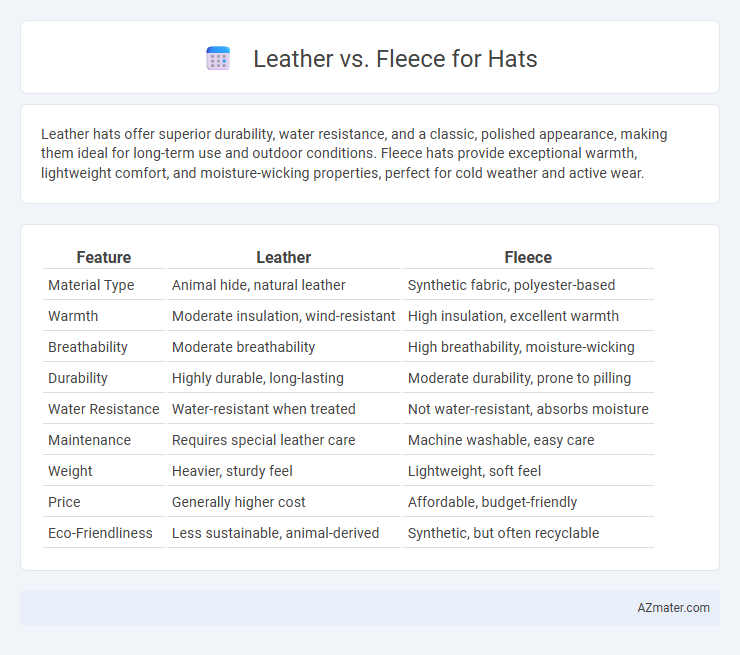Leather hats offer superior durability, water resistance, and a classic, polished appearance, making them ideal for long-term use and outdoor conditions. Fleece hats provide exceptional warmth, lightweight comfort, and moisture-wicking properties, perfect for cold weather and active wear.
Table of Comparison
| Feature | Leather | Fleece |
|---|---|---|
| Material Type | Animal hide, natural leather | Synthetic fabric, polyester-based |
| Warmth | Moderate insulation, wind-resistant | High insulation, excellent warmth |
| Breathability | Moderate breathability | High breathability, moisture-wicking |
| Durability | Highly durable, long-lasting | Moderate durability, prone to pilling |
| Water Resistance | Water-resistant when treated | Not water-resistant, absorbs moisture |
| Maintenance | Requires special leather care | Machine washable, easy care |
| Weight | Heavier, sturdy feel | Lightweight, soft feel |
| Price | Generally higher cost | Affordable, budget-friendly |
| Eco-Friendliness | Less sustainable, animal-derived | Synthetic, but often recyclable |
Introduction: Understanding Leather and Fleece Hats
Leather hats offer durability and a classic, rugged aesthetic favored for outdoor activities and fashion, while fleece hats provide superior warmth and softness ideal for cold weather and active wear. Leather is a natural material known for its breathability and resistance to wind and moisture, whereas fleece, made from synthetic fibers, excels in insulation and quick-drying properties. Choosing between leather and fleece hats depends on the intended use, climate, and desired style preferences.
Material Overview: Leather vs Fleece
Leather hats offer durability and natural water resistance, making them ideal for rugged outdoor use, while fleece hats prioritize warmth and breathability, providing excellent insulation in cold weather. Leather, derived from animal hides, is sturdy and ages with character, whereas fleece, a synthetic fabric made from polyester, is lightweight, soft, and quick-drying. Choosing between leather and fleece materials depends on the desired balance between toughness and thermal comfort for headwear applications.
Durability and Longevity Comparison
Leather hats offer exceptional durability due to their tough, natural fibers that resist tears, abrasions, and weather damage, often lasting for decades with proper care. Fleece hats, while soft and comfortable, tend to wear out faster, with fibers prone to pilling and thinning after frequent use and washing. In terms of longevity, leather outperforms fleece, maintaining its shape and protective qualities much longer in varied environmental conditions.
Comfort and Wearability Factors
Leather hats provide excellent durability and a classic style but may feel stiffer and less breathable, potentially causing discomfort during prolonged wear. Fleece hats offer superior softness, warmth, and moisture-wicking properties, making them ideal for cold weather and active use. The choice between leather and fleece hinges on the need for ruggedness versus lightweight comfort and breathability.
Weather Resistance: Warmth and Protection
Leather hats provide excellent weather resistance with natural water repellency and windproof qualities, making them ideal for wet and windy conditions. Fleece hats offer superior warmth through insulating synthetic fibers that trap heat effectively, but they lack strong water resistance and can become saturated in heavy rain. For balanced protection in harsh weather, leather shields against moisture, while fleece ensures thermal insulation, often leading to combined leather-fleece designs for optimal performance.
Style and Aesthetic Differences
Leather hats offer a sleek, polished appearance with a timeless, rugged appeal, often associated with classic fashion and high durability. Fleece hats provide a soft, textured look that conveys warmth and casual comfort, making them ideal for outdoor and sporty styles. The contrast between leather's smooth, shiny finish and fleece's matte, plush surface creates distinct visual and tactile experiences, influencing the overall aesthetic of headwear choices.
Maintenance and Cleaning Requirements
Leather hats require regular conditioning with specialized leather care products to prevent drying and cracking, and should be cleaned gently with a damp cloth to avoid damaging the material. Fleece hats are easier to maintain, as they can usually be machine washed on a gentle cycle and air dried to preserve softness and shape. While leather demands more meticulous care to maintain its durability and appearance, fleece offers low-maintenance performance suitable for frequent cleaning.
Price and Affordability Analysis
Leather hats typically command higher prices due to the cost of genuine animal hides and the labor-intensive tanning process, making them a premium choice. Fleece hats are more affordable, driven by inexpensive synthetic fibers and mass production, offering budget-friendly warmth and comfort. Consumers seeking durability and luxury often opt for leather, while those prioritizing cost-effectiveness and lightweight insulation lean towards fleece.
Environmental Impact and Sustainability
Leather production generates significant environmental impact due to high water consumption, methane emissions from livestock, and toxic chemical use in tanning processes. Fleece, typically made from synthetic fibers like polyester, relies on petroleum resources and contributes to microplastic pollution in waterways. Choosing sustainable hat materials often favors recycled or organic fleece alternatives over conventional leather to reduce carbon footprint and ecological damage.
Choosing the Right Hat: Leather or Fleece?
Leather hats offer durability, water resistance, and a classic, stylish appearance ideal for outdoor use and colder, wetter climates. Fleece hats provide superior warmth, lightweight comfort, and moisture-wicking properties, making them perfect for active wear and cold, dry conditions. Choosing the right hat depends on the balance between weather protection, comfort, and style preferences tailored to specific activities and environments.

Infographic: Leather vs Fleece for Hat
 azmater.com
azmater.com